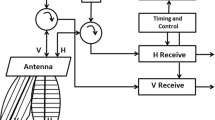Abstract
The polarimetric distortion in the PolSAR datasets causes the polarimetric decomposition and classification techniques to produce wrong outputs, which result in misinterpreting the scattering phenomenon and the ground targets. The most important polarimetric distortions in airborne PolSAR datasets are the channel imbalance and crosstalk. The minimization of these polarimetric distortions using polarimetric calibration techniques is very important to carry out the quantitative analysis using PolSAR data and time-series analysis and to compare the results between different sensors. The objective of this study was to implement the external polarimetric calibration of the L-band UAVSAR system using trihedral corner reflectors. The polarimetric distortion matrix (PDM) was formulated after considering the crosstalk and channel imbalance polarimetric distortions to derive the scattering matrix free from all kinds of polarimetric distortions from the observed scattering matrix. The channel imbalance between different polarization channels was estimated with the help of trihedral corner reflectors and homogeneously distributed targets. The crosstalk parameters were estimated by assuming the scattering reciprocity constraint, which is valid in the case of monostatic radars. The scattering matrix free from polarimetric distortions was derived from the PDM after estimating the polarimetric distortions. The polarimetric signatures and the coherency matrix behaviour of the trihedral corner reflectors were used to analyse the ground target characterization improvement after polarimetric calibration.







Similar content being viewed by others
References
Ali, Z., Barnard, I., Fox, P., Duggan, P., Gray, R., Allan, P., et al. (2004). Description of RADARSAT-2 synthetic aperture radar design. Canadian Journal of Remote Sensing, 30(3), 246–257. https://doi.org/10.5589/m03-078.
Babu, A., Kumar, S., & Agrawal, S. (2019a). Polarimetric calibration of RISAT-1 compact-pol data. IEEE Journal of Selected Topics in Applied Earth Observations and Remote Sensing, 12(10), 3731–3736. https://doi.org/10.1109/JSTARS.2019.2932019.
Babu, A., Kumar, S., & Agrawal, S. (2019b). RISAT-1 compact polarimetric calibration and decomposition. Proceedings, 18(1), 3. https://doi.org/10.3390/ecrs-3-06189.
Chang, Y., Li, P., Yang, J., Zhao, J., Zhao, L., & Shi, L. (2018). Polarimetric calibration and quality assessment of the GF-3 satellite images. Sensors (Switzerland), 18(2), 1–12. https://doi.org/10.3390/s18020403.
Duan, D., & Wang, Y. (2017). An improved algorithm to delineate urban targets with model-based decomposition of PolSAR data. Remote Sensing. https://doi.org/10.3390/rs9101037.
Fore, A. G., Chapman, B. D., Hawkins, B. P., Hensley, S., Jones, C. E., Michel, T. R., et al. (2015). UAVSAR polarimetric calibration. IEEE Transactions on Geoscience and Remote Sensing, 53(6), 3481–3491. https://doi.org/10.1109/TGRS.2014.2377637.
Gibbs, Y. (2015). NASA Dryden Fact Sheets—The Dry Lakes. Retrieved from https://www.nasa.gov/centers/armstrong/news/FactSheets/FS-086-DFRC.html.
JPL. (2018). Calibration - UAVSAR. Retrieved December 25, 2018, from https://uavsar.jpl.nasa.gov/cgi-bin/calibration.pl.
Jung, Y., & Park, S.-E. (2018). Comparative analysis of polarimetric SAR calibration methods. Remote Sensing, 10(12), 2060. https://doi.org/10.3390/rs10122060.
Kimura, H., Mizuno, T., Papathanassiou, K. P., & Hajnsek, I. (2004). Improvement of polarimetric SAR calibration based on the Quegan algorithm. IGARSS 2004. in 2004 IEEE International Geoscience and Remote Sensing Symposium, 1(C), (pp. 184–187). https://doi.org/10.1109/igarss.2004.1368990.
Quegan, S. (1994). A unified algorithm for phase and cross-talk calibration of polarimetric data-theory and observations. IEEE Transactions on Geoscience and Remote Sensing, 32(1), 89–99. https://doi.org/10.1109/36.285192.
Rosen, P. A., Hensley, S., Wheeler, K., Sadowy, G., Miller, T., Shaffer, S., & Madsen, S. (2006). UAVSAR: A new NASA airborne SAR system for science and technology research. in IEEE National Radar Conference—Proceedings, (May), (pp. 22–29). https://doi.org/10.1109/RADAR.2006.1631770.
Rosen, P. A., Hensley, S., Wheeler, K., Sadowy, G., Miller, T., Shaffer, S., & Zebker, H. (2007). UAVSAR: New NASA Airborne SAR System for Research. in IEEE A&E Systems Magazine, (November).
Sharma, S., Dadhich, G., Rambhia, M., Mathur, A. K., Prajapati, R. P., Patel, P. R., et al. (2017). Radiometric calibration stability assessment for the risat-1 sar sensor using a deployed point target array at the desalpar site, rann of kutch, india. International Journal of Remote Sensing, 38(23), 7242–7259. https://doi.org/10.1080/01431161.2017.1371858.
Sun, G., Huang, L., Chen, K., & Han, C. (2017). An efficient polarimetric SAR calibration algorithm using corner reflectors. Canadian Journal of Remote Sensing, 43(3), 286–296. https://doi.org/10.1080/07038992.2017.1330142.
Ullmann, T., Schmitt, A., & Jagdhuber, T. (2016). Two component decomposition of dual polarimetric HH/VV SAR Data: Case study for the tundra environment of the mackenzie delta region. Canada. Remote Sensing. https://doi.org/10.3390/rs8121027.
Van Zyl, J., & Kim, Y. (2010). Synthetic Aperture Radar Polarimetry. In: J. H. Yuen (Ed.) Jet Propulsion Laboratory, California Institute of Technology, California, JPL Space Science & Technology Book Series (1st edition). https://descanso.jpl.nasa.gov/SciTechBook/st_series2_chapter.html.
Wang, C., Yan, H., Wang, Y., & Yu, W. (2013). Polarimetric calibration requirements on several classification schemes for land application of polarimetric synthetic aperture radar. IET Radar, Sonar and Navigation, 7(2), 113–122. https://doi.org/10.1049/iet-rsn.2012.0152.
Yuan, L., Ge, J., Jiang, K., & Wang, Y. (2009). Research on efficient calibration techniques for airborne SAR systems. APSAR 2009—2009 Asia-Pacific Conference on Synthetic Aperture Radar, Proceedings, (pp. 266–269). https://doi.org/10.1109/APSAR.2009.5374089.
Acknowledgement
Authors are thankful to JPL/NASA for providing the UAVSAR L-band dataset and the details of the trihedral corner reflectors.This research is carried under the NISAR L&S Airborne SAR (ASAR) project (Code Mis-01) on Polarimetric SAR calibration of L- and S-band PolSAR data for scattering information retrieval of Manmade and Natural Features. The authors are grateful to the Indian Space Research Organisation (ISRO) for approving this project.
Author information
Authors and Affiliations
Corresponding author
Additional information
Publisher's Note
Springer Nature remains neutral with regard to jurisdictional claims in published maps and institutional affiliations.
About this article
Cite this article
Babu, A., Kumar, S. & Agrawal, S. Polarimetric Calibration of L-Band UAVSAR Data. J Indian Soc Remote Sens 49, 541–549 (2021). https://doi.org/10.1007/s12524-020-01241-1
Received:
Accepted:
Published:
Issue Date:
DOI: https://doi.org/10.1007/s12524-020-01241-1




